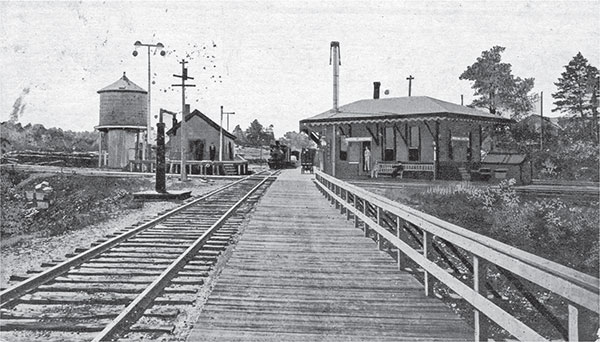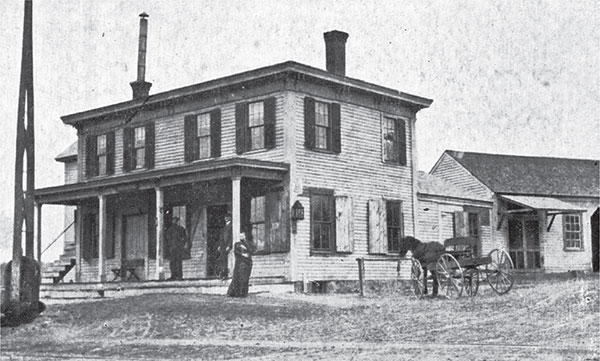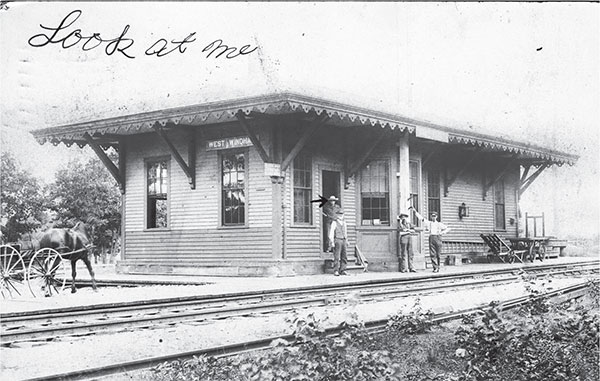
A postcard view of Windham Junction as it appeared circa 1910. Author’s collection.
9
THE RAILROAD COMES TO WINDHAM
Although extensive railway systems began to appear in the United States as early as the first decades of the nineteenth century, it would be years before this revolutionary technology connected the nation’s rural towns to larger cities. Railroads came through small, isolated towns with promises of a more efficient method for farmers and local craftsman to bring their products to market. Once travel by railroad became commonplace decades later, the railway systems that were already in place allowed for a convenient way for those living in rural towns, such as Windham, to go to the city for the day or just visit friends a couple towns over.
The first railroad to lay its tracks in Windham was the Manchester & Lawrence Railroad, which first came to town in 1848. After a year of construction, the railroad was open for business in 1849; the first train to ride along the newly laid tracks did so on November 11 of that year. As the train was to stop in Windham, a station was erected on the west side of the tracks where two existing roads crossed. A cattle pass had to be built under the tracks so the cattle of a nearby farmer could safely cross the road. From this station, the train would have continued on toward the town line between Windham and Salem near Canobie Lake. When the track was laid at this section of town, the crew ran into difficulty as they were forced to cut through rock. To do so required many hours of hard labor with hand tools, as well as primitive blasting technology using nothing but black powder.
A much different problem occurred when workmen began laying track near Mitchell’s Pond. The roadbed happened to be over an old meadow, and as such, the ground was not very firm. The road would continually sink, requiring a persistent effort on the part of the workmen to continually fill in the area beneath the bed until at last the ground was solid enough to support the weight of a train.
The Manchester & Lawrence operated independently for just under one year before it was leased to the Concord Railway, but it reverted back to independent ownership after a few years. However, it was not long before the railway was again leased by several other railways, and it was ultimately leased by the Boston & Maine Railroad for fifty years; the Boston & Maine purchased the Manchester & Lawrence outright in 1919 through a stock exchange.
However, the Manchester & Lawrence was not the only line to come through Windham. Through a series of consolidations and leases beginning in 1848, the Nashua & Epping Railroad eventually made its way through Windham in 1874 after being leased by the Worcester & Nashua Railroad. Before the construction was even started on the Worcester & Nashua Railroad, the company had leased the Nashua & Rochester Railroad for a term of fifty years. In 1883, the two railroads merged to become the Worcester, Nashua & Rochester Railroad. As the Boston & Maine began to dominate the region, as well as much of the Northeast, the railroad conglomerate leased the Worcester, Nashua & Rochester and later purchased it in 1911. Although the Boston & Maine eventually dominated the railroads of Windham, one cannot overlook the history of the railways in Windham prior to the Boston & Maine.
When the Nashua & Rochester Railroad laid its track through Windham, the route crossed over the already existing route of the Manchester & Lawrence. Although this occurred just under four hundred feet from the preexisting Windham station, a new station was built by the Nashua & Rochester to accommodate a greater amount of passengers. The new $2,200 station was composed of two equal-sized wings, each of which had a waiting room for the passengers. The old station was later moved about two hundred feet and was no longer used by passengers. Instead, it became a general purpose building, at times serving as a home for the gate crossing attendant and his family. On the occasion of a layover where railway workers or others were stuck in Windham for a night, they would be offered the opportunity to board at the former train station.

A postcard view of Windham Junction as it appeared circa 1910. Author’s collection.
As trains were routinely passing through Windham to deliver and pick up freight, it was necessary for Windham Junction to have a freight house. It is recorded that in 1869, an old passenger station from Salem was brought to Windham Junction and refurbished to store freight, as well as the handcars. It is believed that this building was later used as a grain store when more modern buildings were constructed near the site. The growth of the railroad also required the construction of other structures, including a water tank. When the first water tank in Windham was constructed in the latter part of the nineteenth century, it was relatively short, with legs that were only ten feet high. Sometime around the turn of the twentieth century, it was raised in order to meet railroad standards.
Businesses, as well as a post office, were built so that they were in proximity of the town’s railroad stations. When Edwin Stickney built his store in 1861, his property became one of the most extensive structures along the railway; it included the general store, a barn and several attached horse sheds. Stickney not only ran a rather successful business but also left his mark on the railroad industry. He was responsible for the construction of two crossings designed for where the railroad crosses another road; the roads being Frost and Depot Road. Eventually such crossings were designated as “Stickney’s” in the timetables issued to the employees of the Boston & Maine.
George Seavey also took advantage of the railroad and built his sawmill near the tracks of the Manchester & Lawrence in 1868. However, the building burned several years later; it was rebuilt in 1877, and the new mill was larger than its predecessor. Its sixty-five-foot-tall square brick chimney rose high above anything that had been constructed in Windham at the time, making it a striking symbol of Seavey’s business. The nearby railroad would have allowed Seavey to easily ship his lumber to interested buyers. Seavey later opened a cider mill on the site, a business that thrived with easy access to railways that could ship the cider to larger cities and towns. His prominence in town helped him to draw support when he worked with other people of influence in order to prevent shoe factories from being built near Windham Junction. Seavey, along with others, was able to convince the local landowners to not sell their land, and the shoe companies were forced to build their factories farther north in Derry. The shoe industry was responsible for much of the industrial development in that town.

An early postcard view of the depot at Windham Junction. Notice the train approaching the station. Author’s collection .

Circa 1910 view of Stickney’s general store at Windham Junction. Author’s collection.

Early postcard of George Seavey’s mill complex at Windham Junction showing the six-story brick chimney. Author’s collection.
When the dairy industry in town began to become sizeable in the last quarter of the nineteenth century, a milk car was added to the railway in order to transport much of the milk produced in Windham. Local farmers were able to bring their milk to the nearest train station, where it would eventually be delivered to the H.P. Hood facility in South Lawrence. One local dairy farm, the Lamson farm, utilized the railway to transport the milk and other products produced at the farm to the Lamson store in Boston. Not only was the refrigerated car far superior to early deliveries made by horse-drawn carriages, but the train car was also able to transport more in much less time.
In 1910, the “Junction” in Windham Junction was officially removed from the name, and the station became known simply by the name of the town in which it stood. The station agent there usually had two operators who worked with him in order to perform the necessary duties of running a train station. At one point, both of the operators were women, an occurrence that is not recorded as happening anywhere else along the Boston & Maine line prior to that time. A train collision near West Windham Station in 1907 resulted in the name of that station being changed to Anderson Station in order to avoid confusion with the other Windham station. This was likely helpful in preventing another accident.
When the Bar Harbor Express opened in 1902 as a joint venture between the Boston & Maine and other railroads, the line passed through Windham for a decade of consecutive summers. When the train would pass by the Windham station, many nearby families would wake up their children early in the morning and bring them down to see the train that carried the millionaires. As Bar Harbor was a popular summer retreat for the wealthy in the Northeast, it would not be uncommon for well-known millionaires from New York or Massachusetts to ride as passengers on the train. However, this tradition did not last long, as the Bar Harbor Express was rerouted around Windham in 1912.
In 1927, a fire broke out at the general store at the Junction that destroyed the store and all of the attached buildings. The store’s proprietor and postmaster, Otis Clyde, rebuilt the store to sell groceries, as well as a small stock of other essential items. When cars became more commonplace in Windham, gasoline pumps were installed, and this was a rather successful business for Clyde. However, the store was short-lived and was closed in 1945; the structure was torn down two decades later.

The station at West Windham, later known as Anderson Station. The station agent and railway workers can be seen in front of the station. Author’s collection .
At the same time, the railroad service through Windham was also beginning to fade out. By the 1930s, freight service had been discontinued, and passenger service was even reduced to just a single round trip once a day, save for Sunday. A passenger train stopped in Windham for the last time on July 10, 1953. By this time, most residents had access to a car, and the town and state roads were adequate enough for fairly efficient, easy travel by automobile.